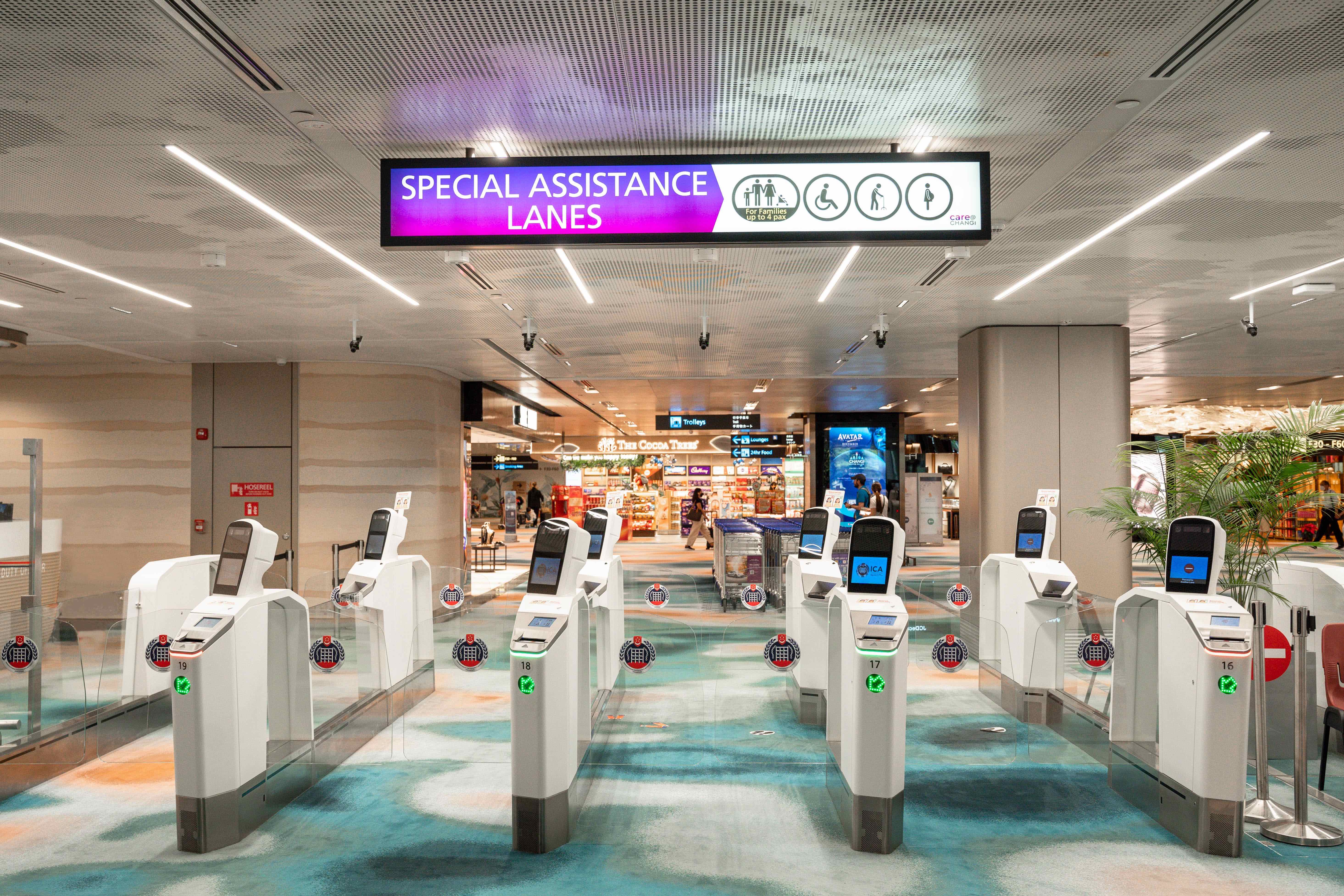Revolutionizing Borders: The Ultimate Guide To Automated Immigration System
Listen up, folks. The world's moving faster than ever, and so is the way we manage borders. Automated immigration systems are no longer just a futuristic idea—they're here, and they're changing the game. Imagine walking through an airport terminal without the hassle of long lines, manual checks, or paperwork. Sounds too good to be true? Well, it's not. Automated immigration systems are making this a reality, one checkpoint at a time.
In this ever-evolving global landscape, technology has stepped up to streamline processes that were once painfully slow. From biometric scanners to AI-powered analytics, these systems are designed to make traveling safer, smarter, and more efficient. Whether you're a frequent flyer or someone who’s just curious about how the future of immigration works, this article dives deep into the nitty-gritty details you need to know.
But hold up, why should you care? Because automation isn’t just about convenience—it’s about security, accuracy, and ensuring that our borders remain protected in a world where threats can come from anywhere. Let’s break it all down, shall we?
- Pirata De Sinaloa The Untold Story Of Mexicos Most Infamous Cartel
- Atz Kilcher Obituary A Heartfelt Tribute To A Life Welllived
What Exactly is an Automated Immigration System?
Alright, let’s get the basics out of the way. An automated immigration system is essentially a tech-driven solution designed to handle immigration processes with minimal human intervention. Think of it as the border control version of self-checkout at your local grocery store, but way cooler. These systems use advanced technology like facial recognition, fingerprint scanning, and even iris detection to verify travelers’ identities quickly and accurately.
Now, you might be wondering, “How does this actually work?” Great question. Here’s the deal: When you arrive at a border checkpoint equipped with an automated immigration system, you’ll typically go through a series of steps. First, your passport or travel document gets scanned. Then, biometric data like your face or fingerprints is matched against records in a secure database. If everything checks out, you’re good to go—no questions asked, no forms to fill out.
And here’s the kicker: these systems don’t just speed things up; they also reduce the chances of errors. Manual checks can sometimes lead to mistakes, but machines? They’re pretty darn reliable. So, next time you’re jet-setting across the globe, chances are you’ll encounter one of these bad boys at some point.
- Megan Thee Stallion Height In Feet The Real Deal Behind The Queens Height
- Rick Owns Wife A Fascinating Dive Into Modern Relationships And Beyond
Why Are Automated Immigration Systems Important?
Let’s face it—traveling used to be a lot simpler back in the day. You’d show up at the airport, hand over your passport, and off you’d go. But as the world becomes more connected, the number of travelers has skyrocketed, and so have the security concerns. That’s where automated immigration systems come in.
First off, they save time. A lot of it. Traditional immigration checks can take forever, especially during peak travel seasons. With automated systems, you can breeze through checkpoints in a matter of seconds. No more standing in line for hours, no more feeling like you’re stuck in some never-ending queue.
But it’s not just about convenience. These systems also enhance security. By using biometric data, they ensure that the person entering a country is who they claim to be. This helps prevent identity fraud and keeps potential threats at bay. Plus, with real-time analytics, authorities can monitor suspicious activities and respond quickly if needed.
The Benefits of Going Automated
Still not convinced? Here’s a quick rundown of why automated immigration systems are worth the hype:
- Increased Efficiency: Faster processing times mean happier travelers and smoother operations for airports and border checkpoints.
- Improved Security: Biometric verification reduces the risk of identity theft and unauthorized entry.
- Cost-Effective: While the initial investment might be high, the long-term savings on manpower and resources are significant.
- Enhanced Traveler Experience: Who doesn’t love a seamless travel experience? Automated systems make the journey less stressful and more enjoyable.
How Do Automated Immigration Systems Work?
Alright, let’s dive a little deeper into the tech behind these systems. At its core, an automated immigration system relies on three main components: hardware, software, and databases. Here’s how they all come together to create a smooth operation.
Hardware Components
The hardware side of things includes all the physical equipment used in the process. Think passport scanners, biometric sensors, and kiosks. These devices are designed to capture and process data quickly and accurately. For example, a facial recognition camera can snap a photo of you and compare it to the image stored in your passport’s chip in a matter of seconds.
Software Components
On the software side, there’s a lot going on behind the scenes. Special algorithms analyze the data collected by the hardware and match it against records in secure databases. These algorithms are constantly being updated to improve accuracy and performance. Some systems even use machine learning to adapt to new threats and trends.
Data Management
Finally, there’s the database component. This is where all the traveler information is stored and managed. These databases are highly secure and protected by advanced encryption techniques to prevent unauthorized access. They also allow for real-time updates, which means authorities always have the latest information at their fingertips.
Challenges and Concerns
Of course, no system is perfect, and automated immigration systems are no exception. There are a few challenges and concerns that need to be addressed to ensure these systems work effectively and ethically.
One major concern is privacy. Collecting and storing biometric data raises questions about how this information is used and who has access to it. It’s crucial for governments and organizations to implement strict regulations and safeguards to protect travelers’ personal data.
Another challenge is the potential for bias in AI algorithms. If the data used to train these systems is skewed, it could lead to unfair treatment of certain groups. That’s why it’s important to continuously monitor and refine these algorithms to ensure fairness and accuracy.
Addressing Privacy Concerns
To tackle privacy issues, many countries are adopting strict data protection laws. For example, the European Union’s General Data Protection Regulation (GDPR) sets high standards for how personal data should be handled. Similar regulations are being implemented around the world to ensure that travelers’ information is kept safe and secure.
Ensuring Fairness and Accuracy
When it comes to AI bias, transparency is key. Organizations need to be open about how their algorithms work and allow for independent audits to verify their fairness. Additionally, involving diverse teams in the development process can help identify and address potential biases before they become a problem.
Real-World Examples of Automated Immigration Systems
So, where are these automated immigration systems actually being used? Let’s take a look at a few real-world examples to see how they’re transforming border control.
Singapore’s Automated Border Control
Singapore is often cited as a leader in adopting cutting-edge technology for immigration. Their automated border control system uses facial recognition and fingerprint scanning to process travelers quickly and efficiently. This has significantly reduced wait times at Changi Airport, one of the busiest airports in the world.
US Customs and Border Protection’s Biometric Entry-Exit System
In the United States, the Customs and Border Protection agency has implemented a biometric entry-exit system at several major airports. This system uses facial recognition to verify the identities of travelers entering and leaving the country. It’s part of a broader effort to modernize border security and improve the traveler experience.
The Future of Automated Immigration Systems
Looking ahead, the possibilities for automated immigration systems are endless. As technology continues to evolve, we can expect these systems to become even more advanced and capable. Here are a few trends to watch out for:
- Integration with Other Systems: In the future, automated immigration systems may be integrated with other travel-related systems, such as baggage handling and lounge access.
- Enhanced AI Capabilities: AI will play an even bigger role in analyzing data and detecting potential threats, making these systems even smarter and more efficient.
- Global Standards: As more countries adopt automated systems, there will be a push towards creating global standards to ensure compatibility and consistency.
Predictions for the Next Decade
Within the next decade, we may see fully autonomous border checkpoints where travelers can complete their immigration processes without any human interaction. Imagine walking through a futuristic gateway that scans your face, checks your documents, and grants you entry—all within seconds. It sounds like science fiction, but it’s closer to reality than you might think.
Expert Insights and Industry Opinions
Before we wrap things up, let’s hear what the experts have to say about automated immigration systems. According to Dr. Jane Smith, a leading researcher in border security technology, “These systems represent a major leap forward in how we manage immigration. They offer a perfect balance of convenience, security, and efficiency.”
Meanwhile, industry insiders are optimistic about the future of automation in border control. “The demand for faster and more secure travel solutions is only going to increase,” says John Doe, CEO of a major tech company specializing in immigration systems. “We’re excited to be at the forefront of this revolution.”
Conclusion: Embracing the Future of Border Control
And there you have it, folks. Automated immigration systems are here to stay, and they’re shaping the future of global travel. From faster processing times to enhanced security measures, these systems offer countless benefits for both travelers and authorities.
So, what can you do? If you’re planning a trip anytime soon, keep an eye out for airports and border checkpoints that use automated systems. Trust us, once you experience the convenience, you’ll never want to go back to the old ways.
Oh, and don’t forget to share this article with your friends and family. The more people know about these amazing systems, the better. Who knows? Maybe one day, we’ll all be zipping through borders without even breaking a sweat.
Table of Contents
- What Exactly is an Automated Immigration System?
- Why Are Automated Immigration Systems Important?
- How Do Automated Immigration Systems Work?
- Challenges and Concerns
- Real-World Examples of Automated Immigration Systems
- The Future of Automated Immigration Systems
- Expert Insights and Industry Opinions
- Conclusion: Embracing the Future of Border Control
- Louis Litt Girlfriend The Inside Scoop On The Suits Stars Love Life
- Mike Shanahan The Football Legend Who Revolutionized The Game

Macy Visa Immigration Specialist Phnom Penh

S'poreans & PRs to still have dedicated lanes when automated

HTX Flying through automated immigration clearance